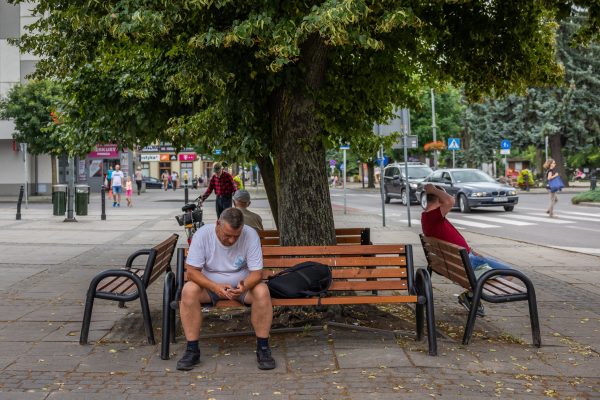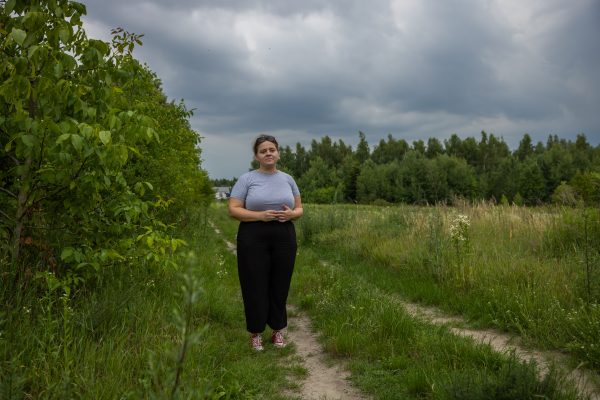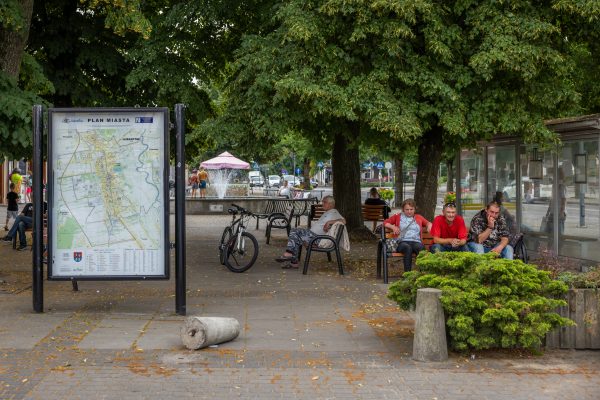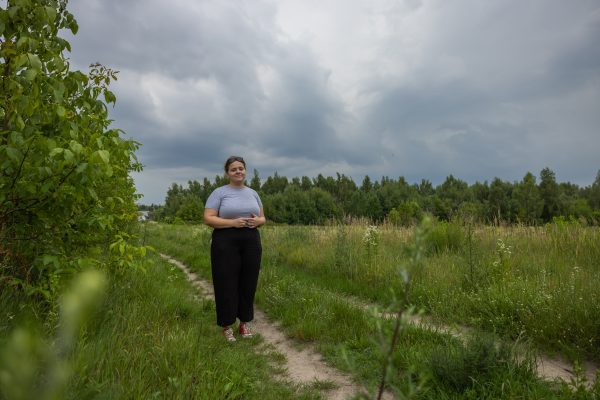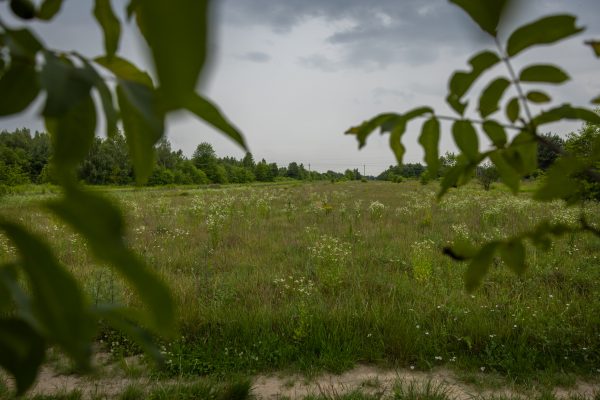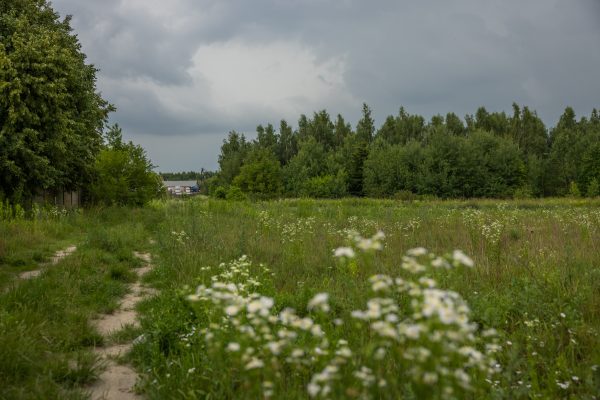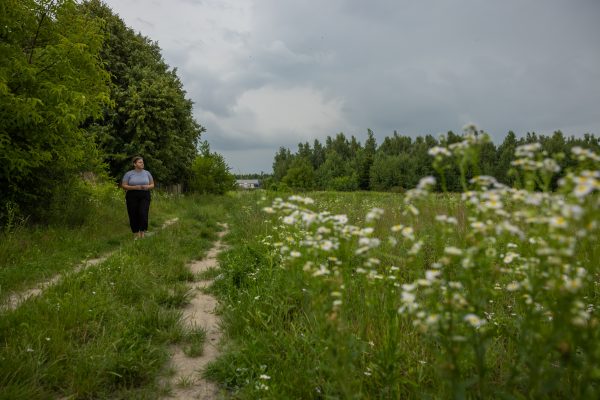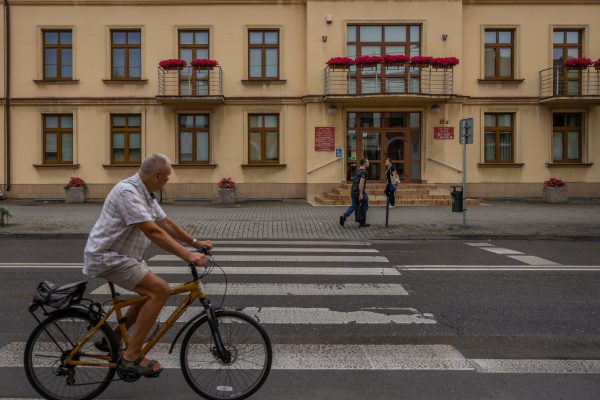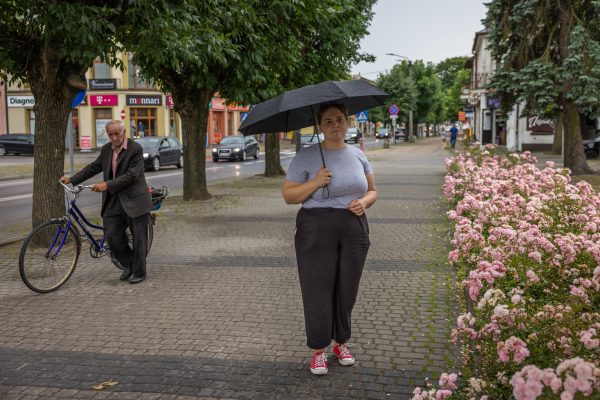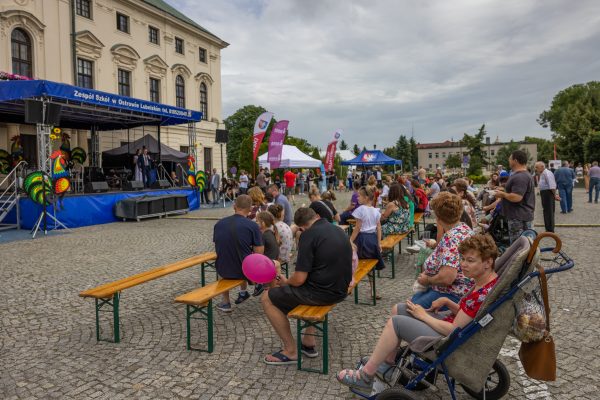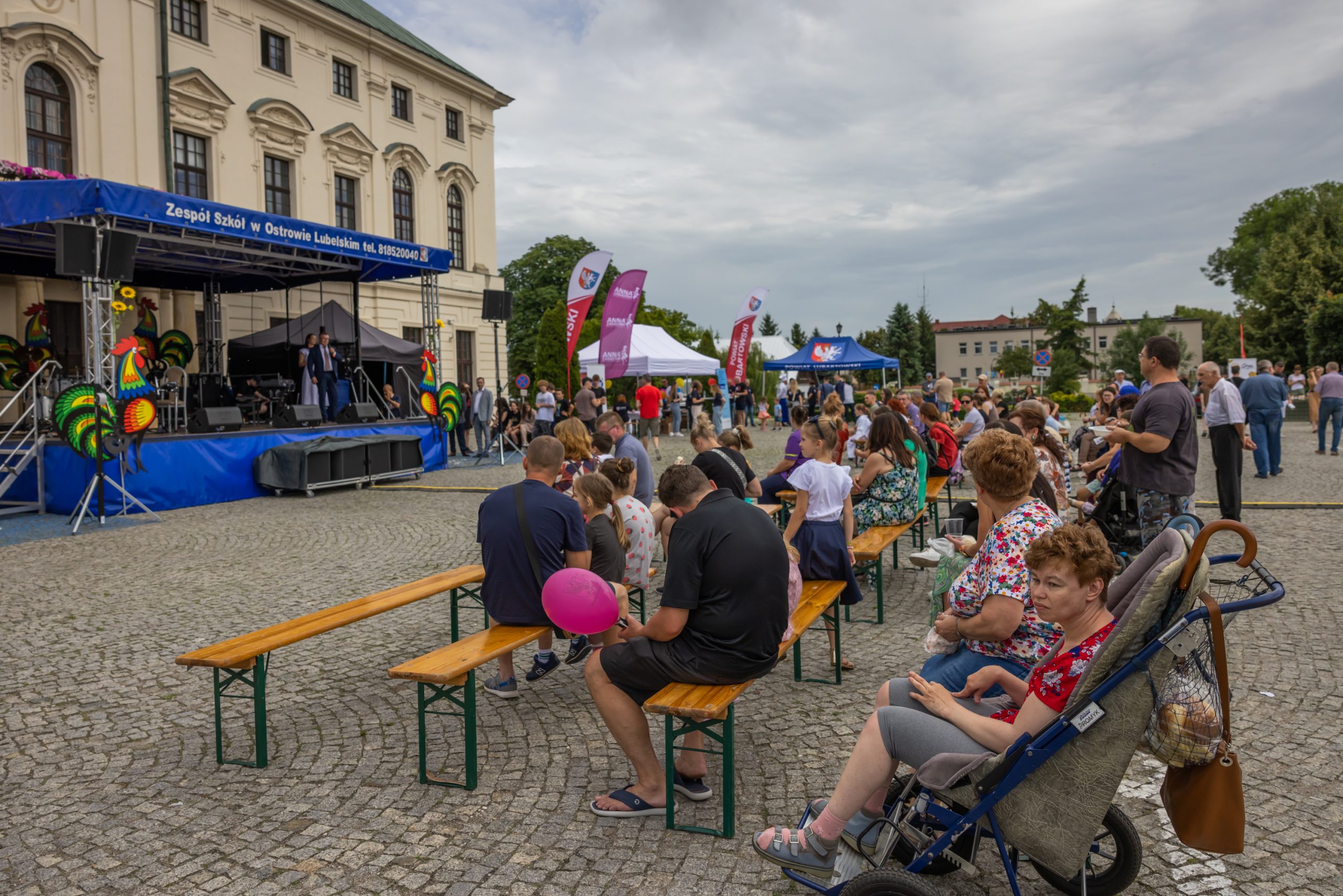
There does not seem to be anything special about the disputed site. It is meadowland overgrown with grass and clumps of hypericum, and daisies as well, in places. Nearby, in the bushes, lives a family of moose. However, a sorting centre could be built here shortly, and that centre will attract HGVs and tankers loaded with chemical waste. Dark clouds are now gathering above the meadows, and a storm is about to break. I am walking across the wet grass on the disputed site with Jagoda Włoch, who has been a councillor on the Lubartów municipal council for many years. She is talking about a different kind of storm – the one concerning the sorting centre, a row which has been going on for two years.
– Investment projects are needed because the municipality does not have any money, and in addition there are not too many jobs – she emphasises. – The problem is that the residents were not properly consulted regarding the plan. Today they resent the way they have been treated.
The Lubartów sorting centre
There are three turning points that need to be discussed to understand why they have become despondent.
The first occurred around 2013, when it was suggested that agricultural land in the vicinity of national road 19 could be made into an economic zone. There is little agriculture potential here, and people preferred to sell the land, and would prefer that it be for commercial use – retail, workshops, shopping centres. The process of reclassification of the land dragged on for years, the applications reached Warsaw, and the residents did not hear very much.
The second occurred in 2019, when a motion was carried in the municipal council to amend the zoning plan. That took place during the December session, when the budget had to be approved, and councillors were in a rush to conclude their business, and go home.
– I admit that I voted in favour of the plan – Jagoda Włoch says with a sigh. – I did not take the time to read the documents, while I knew that it was important for something more than agriculture to develop in the municipality.
The third point occurred at the end of August 2022, which was when Jagoda heard from an official that a month before, an application had been submitted for an environmental decision for construction of a sorting centre. The official said only this: There is going to be quite a row there. Jagoda began to read the detailed documents, and found that under the plan there was an option for a pollution zone, which could have major implications for the environment. She saw the list of substances that could be stored there. It was the entire periodic table.
The residents had no idea about this. Naturally, at some point in between these events, the official consultations for the plan had been held, in accordance with the statutory requirement. The authority announced the consultations in the Public Newsletter, on the municipal authority notice board, and in a public place. But who reads the newsletter or announcements in small print on notice boards? Two people attended the consultations.
Discontent began to grow around the question of the sorting centre – people heard that something would be built on the meadowland, but no one knew precisely what. Jagoda contacted the company, and employees took her on a tour of a similar sorting centre in Warsaw. She decided to hold a number of meetings at the community centre to relate all of this to residents. Even at the first meeting, the room was packed to the limit. The atmosphere was tense, with people shouting that they were against construction of the facility, that it would cause an unpleasant smell, and that the local road was not fit for that number of HGVs and tankers. A protest committee was formed. The local deputy mayor did not attend until the third meeting.
Jagoda acknowledges that it took her a long time to recover from those meetings. Even now, her hair stands on end when she recalls the things that were said.
– There is no such thing as decorum in discussions here – she admits, sounding bitter. – People are not accustomed to the possibility of creating the conditions for discussing matters calmly and working together to solve problems.
For this reason, she organised a civic forum in the municipality of Lubartów, and the opportunity happened to present itself. Municipal councils are required to amend zoning plans, studies have been abolished, and now there is a single general plan. This is an opportunity to make changes, and there are a number of grievances in the municipality. There is a landfill site not far away, and there is an ongoing row about this as well. It is not clear what to do with the former sand pit site. The Kozłówka Landscape Park, or for example the Wieprz River Valley, could become a tourist attraction, but they have to be protected against being developed. At the forum, residents would be able to jointly decide their priorities and draw up recommendations to present to the authorities.
The mayor said that the municipal council would not be involved in the forum, saying that it did not have the resources. Fortunately, he did not even get through to the second round in the election held in April, and the new mayor was in favour of a debate.
Jagoda did not expect it to be so hard get residents to become involved. She put announcements on notice boards, in libraries, at the swimming pool, on social media, and even on the local news website, keen to gather a group that was diverse in terms of age, education, and place of residence, Unfortunately, the first attempt was unsuccessful. Jagoda is planning another recruitment drive in August. She will take advantage of the fact that the local mayor wishes to meet with residents of every town and will use the opportunity to talk about the forum and enable people to sign up on the spot.
Meanwhile, she has been able to find experts. A guest speaker from the Warsaw University of Technology will talk to the debate participants about the complicated issues involved in spatial planning. A local official will explain what specific problems the municipality is facing and what needs to be changed. Then there will be time for a discussion – What kind of industry do we want? What areas of the service industry do we want? What kind of jobs do we want to create? How do we stop young people from going to live in Warsaw and keep them in the municipality?
It is possible that a sorting centre will be opened on the disputed land, but as yet no binding environmental decision has been issued. On the other hand, the firm has already obtained various permits, and hired high-profile lawyers. But Jagoda hopes that the entire row will teach the municipal council that it has to work with residents.
– I think that the recommendations drawn up at the forum will temper the mood in the community – she stresses. – and people will also realise that they have agency. We have never said that we don’t want the municipality to grow and that we are against industrial plants. It is a question of making major decisions through dialogue and not quietly in the corridors of power.
Hold a public forum
The formula for a civic forum is simple – three days, a maximum of twenty residents, three or four experts in the matter at hand, and a little bit of willingness to reach a consensus on the recommendations to be made to the authorities. This is a simple formula, because it was developed by the Warsaw Fundacja Pole Dialogu (Field of Dialogue Foundation) through a process of trial and error.
– We came to appreciate that there was a great need to include residents in discussions with authorities in the smaller municipalities – the Foundation’s Eva Mackevica says. – In the large towns, a civic panel can be organised, and the members are appointed at random according to criteria such as age, gender, and level of education. Small and medium-sized municipalities do not usually have the funds for that, and for this reason only public consultations are held, as this is a legal requirement, but they are not always successful. Usually, the municipal council makes announcements asking for residents’ views on a particular matter, and gives the date and time of the meeting. If it is not a hot topic, sometimes no one attends, while if it is a hot topic, the tension prevents an informed discussion from being held, based on the merits. People are infuriated and want to vent their frustration and put the blame on the officials. Often, the same people come to the consultations – those that are concerned and have the time – and this means that the conversation takes place in a bubble. There is an urgent need for an alternative, and for this reason the Fundacja Pole Dialogu made a suggestion to the municipal authorities that civic forums be held.
As long as three years ago, employees at the Foundation tried out various formulas. They organised four forums on a trial basis – in Lesko, Michałowice, Świdwin and Cieszyn. There were four topics to choose from – municipal waste, water retention, greenery in the city, and lowering carbon dioxide emissions. All of the forums lasted three days – half of the time was devoted to instruction, and half to discussion and drawing up the recommendations. But there were minor differences in the way the meetings proceeded. Once each forum had come to an end, a survey was conducted to determine what had worked and what had not.
What worked?
First – the group consisted of residents from different circles, and this made it possible to get to know the neighbours and their specific viewpoints.
Second – working in groups. This made it possible for the participants to express their thoughts freely in the discussion, and take a constructive approach to finding solutions.
Third – varying the forms in which they worked. This prevented the forum from becoming monotonous; the participants kept up energy levels for the duration of the forum.
In general, the score they gave for the experiment was 5+ on a scale of 1 to 6. They were able to learn more about local problems in a short time, forge valuable relationships, and gain a sense of agency and say in decisions made around them.
What didn’t work?
First – it was found that it was not a good idea to meet one day after the next. This did not give residents time to reflect. If people are to give informed opinions, they need space to think it over and have breaks between meetings – of one week, for example.
Second – open recruitment causes problems. Usually, considerably more women and people with higher education sign up. For this reason, the Foundation recommends recruiting by sending personally addressed letters to people’s houses. Unfortunately, this is more expensive.
Finally, the third issue – it is crucial for local experts to be involved. Three or four experts speak at the forum, and more questions are always asked about the local context. The forum is too general if an expert does not attend.
But the most important thing is the Foundation’s recommendation that the participants be paid. This is the established international norm – payment is due for the work done. Not everyone has the time and resources to go to public consultations, let alone a forum that in total can last ten or more hours. If we do not pay, there is a danger that only people who can afford to will attend, and thus the group will not be large, or diverse.
This led to a handbook being produced for people who wish to organise a forum in their municipality to take control over, or prevent, a row concerning a difficult topic.
– Originally, we simply intended to submit materials to the municipal councils – Eva Mackevica explains, – but considering that forums are something new in Poland, we determined that few municipal councils would take up the initiative, if we left it up to them. This led to the idea of providing training for officials and people in CSOs. We also provided money to demonstrate that the forum did not involve great expense.
More than 20 forms were received. The Foundation rejected the applications that did not envisage working with the authorities. Ultimately, people from 14 municipalities did the training, and Jagoda Włoch from Lubartów was one of them. Some have held the forums, others are conducting the recruitment drive.
– We want to create facilities in municipalities for an encounter of various emotions and viewpoints – Eva stresses. – a person overcome with frustration at not being heard will express their emotions in a different way to someone who has been invited to attend a discussion and work out solutions. The forums give people a feeling of agency. People stop feeling forgotten, and feel that they have a real impact on policy.
Trees in Bydgoszcz
Bydgoszcz can boast of its success – the mayor issued an order approving recommendations drawn up in collaboration with residents, concerning greenery in the city. The recommendations were adopted into law. This is the result of the “Bez Lipy” (No Kidding!) project, conducted in the city by the Pracownia Zrównoważonego Rozwoju (Sustainable Development Laboratory). But before that success was achieved, Bydgoszcz was swept by numerous rows. During a road refurbishment, trees were not properly protected, and people protested. Trees began to be cut down on a residential estate, and the residents wondered why the greenery was being destroyed, because no one had informed them that this would happen. Often, the source of these disputes was a failure of communication between the authorities and the community.
– These conflicts prompted the “Bez Lipy” project – Joanna Suchomska of the Pracownia Zrównoważonego Rozwoju explains. – Usually, legal documentation is drawn up mainly by experts. We wanted to test a model in which residents would take part in this process.
The Pracownia asked approximately 40 people from various circles to take part. They formed the Zespół do Spraw Zieleni (Greenery Team). People from the city institutions that issue decisions relating to greenery were invited by name, in a similar way to certain community activists from CSOs, and academics. There was also a representative of the firm responsible for maintaining the green areas. For the residents, meanwhile, open recruitment was organised. It was important that there should be a confrontation between different points of view, so that each person had their say in the discussion.
The inspiration for the talks was Community of Practice. This is a model for conducting dialogue among people who are active in the subject area and want to be better. At the first meeting, the group agreed upon the common goal – to draw up the Bydgoszcz Greenery Norms. The group was then divided into subgroups to deal with specific issues – day-to-day care, protecting greenery in the case of land development, but also the issue of communicating greenery decisions and raising residents’ awareness.
Civic monitoring of trees
Emilia Czekała chaired the subgroup dealing with protecting trees in the case of land development. This was the hottest topic in Bydgoszcz. Emilia knows the most about this, because she is on the board of Stowarzyszenie MODrzew – Monitoring Obywatelski Drzew (Association for the Civic Monitoring of Trees).
It was created in 2020 on the wave of disgust caused by two major cases of felling trees. In the course of construction of a link road between the Kujawskie and Bernardyński roundabouts, approximately 700 trees were cut down. Meanwhile, more than 200 trees were cut down during work on the heating installation in Kapuściska. The authorities’ explanation was that “the trees were growing there without approvals and permits”. While in fact it should be matter of priority to preserve them in the city!
The association’s first project was to create a map of the trees in Bydgoszcz. Volunteers walked around the city, marking on maps each maple, lime, and plane tree, and their dimensions, condition, and coordinates. The map proved useful for example when trees began to be cut down on Szymanowskiego and the residents became upset. The association had detailed information about the trees that were dying or affected by fungus. They could put residents’ minds at rest that there were grounds for cutting down the trees.
This is because the association soon began receiving complaints and queries from people who were concerned. “I see that someone is meddling with the tree, what is going on?” – they asked. At that point, the members of the association filed requests for access to information on the environment – whether approval had been given. They also wrote reports on how many trees were being cut down in Bydgoszcz and for what reasons. Officials were resentful due to the extra work providing the information involved, and not having the equipment to scan documents quickly and effectively. The atmosphere was generally hostile.
The greatest success was saving an avenue of oak trees on the Laskowice – Krąplewice route in 2021. Some residents claimed that there were accidents there due to trees blocking visibility on driveways exiting the properties. Others would call the association, appalled at the loss of very old trees. During an on-site visit, community activists found there a fragrant oak and a protected species of beetle, and the felling was stopped. Unfortunately one-third of the oaks had died by that time.
Emilia does not have qualifications in biology, she is a musician and a conductor of the private Bydgoszcz Symphony Orchestra. She attended a MODrzew meeting by chance, but immediately became involved. She started investigating the importance of trees for the way we feel and for prosperity, and realised that in the city trees are not treated properly.
– We adhere to the principle that even one tree is worth saving, if only to show that every tree is important, especially those that are in their prime – she emphasises. – Trees cleanse the air, and just the sight of them has a calming effect. I would be dismayed if the maple under my window was cut down.
There are also more subtle problems than the felling of trees. When a development begins, the developer does not cut down trees, and thus can boast that there is greenery. However, they are not properly protected, the roots are not protected, the earth around the trunk is pummelled, and inside the earth there is no air. They dry out after five years, and the law does not properly address the issue of a developer’s liability.
The Zespół ds. Zieleni discussed all of these issues, and looked at the norms in effect in other cities. Eventually, in the recommendations, they observed that a Tree Preservation Zone needed to be established (the canopy projection area plus 1.5 metres, and in the case of an aging tree as much as three metres) a fence installed, and a notice placed there saying that access and dumping is prohibited.
The issue of substitution planting was also contentious. If a developer cuts down a tree, they are required to plant a new one, but where and in what quantity? If they cut down large, old trees, are two flimsy sticks sufficient? It’s not even certain whether they will take! They discussed the proportions for a long time. The residents wanted as many new trees as possible, while the officials argued that there was no room in the city to plant them. A compromise had to be reached. They proposed that a special index be used in the norms, to be used to calculate the number of new trees according to species, trunk circumference, condition, and the value for culture and landscape of the tree being cut down.
– In the past, as an association, we usually had the opposite view to officials, but this project enabled the differences to be overcome and the different viewpoints to be understood – Emilia summarises. – Now, when a complaint comes in from residents, we do not rush straightaway to file a request for information. We know now who is responsible, and therefore sometimes it is better to call the person in question and ask.
A trip we took together to Oslo also helped us to integrate. At the City Hall there, officials and community activists from Poland learned how greenery is cared for in the Norwegian capital, and how vehicle traffic is managed. They visited a city district in which the authorities tried to abolish vehicle traffic. Emilia was impressed by the fact that first the streets were closed for a few months to determine whether people would begin to live and take walks on those streets. Only then was a decision made.
Green Callout Service
Paweł Górny of the Bydgoski Ruchu Miejskiego (Bydgoszcz City Movement) was part of the subgroup looking at the subject of roadside greenery. This may be because for a long time his community activity had been centred around roads.
Initially, the association was called Społeczny Rzecznik Pieszych (Community Ombudsman for Pedestrians), and sought to improve conditions for pedestrians in the city. It quickly became clear, however, that to talk about safety of pedestrians meant talking about public transport and spatial planning because the cities are overflowing, causing people to use cars more often, and ultimately about green areas, as they improve the quality of the air, and in turn of life. Therefore they changed the name to Bydgoski Ruch Miejski. Today, they hold consultations on property developments and zoning plans, and are on the city authorities’ advisory bodies – the road safety improvement team, or for example the community participation team.
– At the first Zespół ds. Zieleni meeting, community activists talked about the things that displeased them – felling trees or substitution planting. And the officials kept saying that nothing could be changed. There was large gap – Paweł recalls – There were discussions about selling urban plots to be developed for residential purposes when there were no regulations protecting the existing greenery. The law only states the percentage of space that has to be greenery, which means that a developer only has to design lawns or even a car park in perforated form. Later on, fortunately, the gap between the community activists and officials narrowed.
In the roadside greenery subgroup, there was a discussion about whether to spread salt on the pavement. Then it is pushed over on to the grass, and damages it. Maybe in that case plastic barriers should be installed? Ultimately, the norms said that sand must be used instead of salt. The firm is required to collect the sand and use it the following year. In addition, on streets with particularly heavy traffic, mats have to be used to protect greenery.
The Zielone Interwencje (Green Callout Service) was also an element of the “Bez Lipy!” project. The Pracownia held a competition in which Bydgoszcz residents could nominate sites on which they would like trees or bushes to be planted. The Team chose the sites on which this would take place. One criterion was that the site had to be the property of the city, and the other was that the entrant had to think of a way to involve residents in the planting. By doing this, sites such as the area next to the school on Karłowicza, often driven over by cars, or the square next to the bus stop in Kapuściska, became green areas. The Team proposed in the norms that once a year residents could be given city funds to work together to make the square green.
– Adopting the norms was a great success – Paweł Górny stresses. – They were devised by a diverse group that cared about protecting greenery. I only wonder what will be next. Will the wider community hear about the norms? Will they be respected? Will the Zespół ds. Zieleni meet at least once a year to see what the situation is? Will there be an increase in the budget of the greenery and municipal management department to accompany the norms?
Emilia Czekała of MODrzew points out that they created an important instrument. In April, when the revitalisation of Plac Wolności began in Bydgoszcz, they noticed that a Tree Preservation Zone had not been marked out, even for the most valuable trees – an old plane tree and elm tree, and building materials were being stored beneath the canopy of some trees. Now they have a legal document that they can cite to demand changes.
The document, which officials, residents, and experts worked together to produce, is the best way to prevent rows in the city.
The Pracownia Zrównoważonego Rozwoju “Bez Lipy!” project and the Fundacja Pole Dialogu “Narada Obywatelska o Klimacie” project were carried out using a grant under the Active Citizens Fund – National Programme funded by Iceland, Liechtenstein and Norway using EEA grants.
Text: Urszula Jabłońska
Photos: Anna Liminowicz
The report was published on Onet.pl
